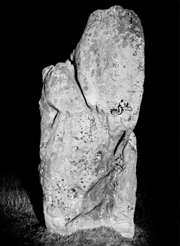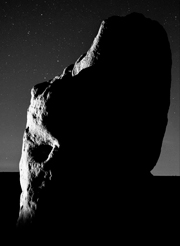|
In Life, In Death - The Eyes Of The Monoliths

|
figure 1
|
figure 2
|
|

|

|
Looking at the Avebury artworks I have wondered why their neolithic creators wanted so many of the carved faces to display large eye sockets. The amount of labour involved to smash and grind these sockets into existence suggests that the sculptors had definite reasons for creating them.
Stone 35a West Kennet Avenue - an illuminating example
Above I set out two small images of the West Kennet Avenue's Stone 35a, a monolith which represents a huge left profiled woman's face complete with a large eye socket (and impressive ceremonial hair arrangement or bun). The photos are lit differently which allows us to consider the eye area under two distinct phases.
I suspect that these deep eye hollows were intended to
allow the carving to represent both the living and dead version of the
character depicted on the stone, depending on the direction of illumination -
if the eye hollow was full of light then the statue was alive (figure 1), if the eye
hollow was shadowed black the face had become a dead skull (figure 2). The
alternation of light and shadow in the eye sockets (depending on the
varying illumination from sun, moon, bonfire or lit torches held aloft in a ceremonial procession) could have
represented the neolithic perpetual cycle of rebirth/death/rebirth displayed on the features of the particular sarsen face. Carved faces with oversized eye sockets are plentiful throughout the Avebury campus - examples (inter alia) can be seen here here and here.
|